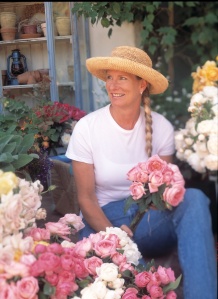A Brief Introduction of Dr. Guoliang Wang
As a rose researcher and expert, Dr. Guoliang Wang has been investigating, collecting, identifying, breeding, and utilizing rose species and heritage roses in China for over 30 years.
In order to obtain first hand live materials, he has carried out over ten field investigations though out China, especially in the remote mountain areas of Yunnan and Sichuan provinces, the natural distribution center of the Genus Rosa, where the Chinese repeat blooming roses were born 1000 years ago. Through his research, nearly 100 rose species and over 200 Chinese heritage roses, derived from Song Dynasty, were collected, morphologically preserved, and systematically identified. Among them, some species or forms were his own discovery.
Some of his fabulous discoveries or rediscoveries, such as the origins of ‘Park’s Yellow Tea-scented China’, ‘Fortune’s Double Yellow’, Rosa laevigatae, with bristles on the flower-branch, Rosa fortuneana without bristles on the peduncle are precious contributions to the world.
Based on his long-term research results, Dr. Wang first presented the viewpoint of the distinct “Six Stages of Evolution of Chinese Ancient Roses”, from the initial stage of remote leaflet fossil, excavated in Shandong, and dated to 20 million years ago, to the final stage of introduction to the West, with abundant, incredible, historical evidence that rose lovers, the world over, might never have read before.
In order to fulfill his rose breeding dream, that new varieties could grow well without any care just like a tree, Dr. Wang has been breeding an unusual series of roses for environmentally friendly planting. His breeding program utilizes wild Chinese species roses as well as modern and old varieties. One strongly perfumed example of his work is the recurrent climber named ‘Fragrant Butterfly’. This cultivar is widely grown and praised highly in China, Japan, Italy, France, and Germany.
Among his many accomplishments he has demonstrated the historical value of old roses in modern time, showcasing his idea that the best old rose conservation is to use them in the present. As an enthusiastic rose landscape gardener – Dr. Wang has designed four old rose gardens in China to show the world the miraculous, revolutionary story of Chinese ancient roses and diversified beauties. This was accomplished by artfully combining different old rose varieties with traditional Chinese gardening elements. In doing so, he has successively created a new model for the conservation of old roses both in public parks and private gardens in China. One of his Heritage Rose Gardens, created using this new concept, was awarded World Federation of Rose Societies Award of Garden Excellence 2012.
Dr. Wang’s first book, Old Roses in China, which has been prefaced by outstanding foreign rose experts, is a complete and comprehensive rose resource. It was published, in Chinese, by China Science Publishing & Media ltd. This volume of over 460 pages, includes nearly all of the Chinese ancient roses and some varieties found abroad. It will soon be translated into English and Japanese, for rose lovers all over the world. This book covers the cradle, or exact location of where the first repeat blooming rose occurred and the exact time it was “born” and the emerging peak of remontant China roses, which took place during the Song Dynasty. These events formed the Tu Mi (Banksiae group) culture, the spreading routes of the rose to the west, the enjoyment of rose paintings in various dynasties, the auspicious meaning of various roses, the arrangement of Chinese roses in the traditional garden, and the identification of nearly 200 old roses through cross-identification of living specimens with ancient records and images. All this and more can be found within its pages.
Dr. Wang has also worked to further the knowledge and importance of the varieties of Chinese ancient roses. He continues to present programs and lectures for rose lovers, at home and abroad. He has spoken to audiences in the United States, France, Germany, Japan, etc.
Born in Yixing, in the beautiful Taihu Lake district in the eastern Chinese province of Jiangsu, the cradle of Chinese ancient classic landscape gardeners, Dr. Wang graduated from the Nanjing Forestry University, and completed his study and co-operation research in Chiba University, Japan. As a professor, today he lectures both at Nanjng University and Nanjing Agricultural University, and continues with his rose research with irreplaceable rose passion as he has done for most of his life.





























